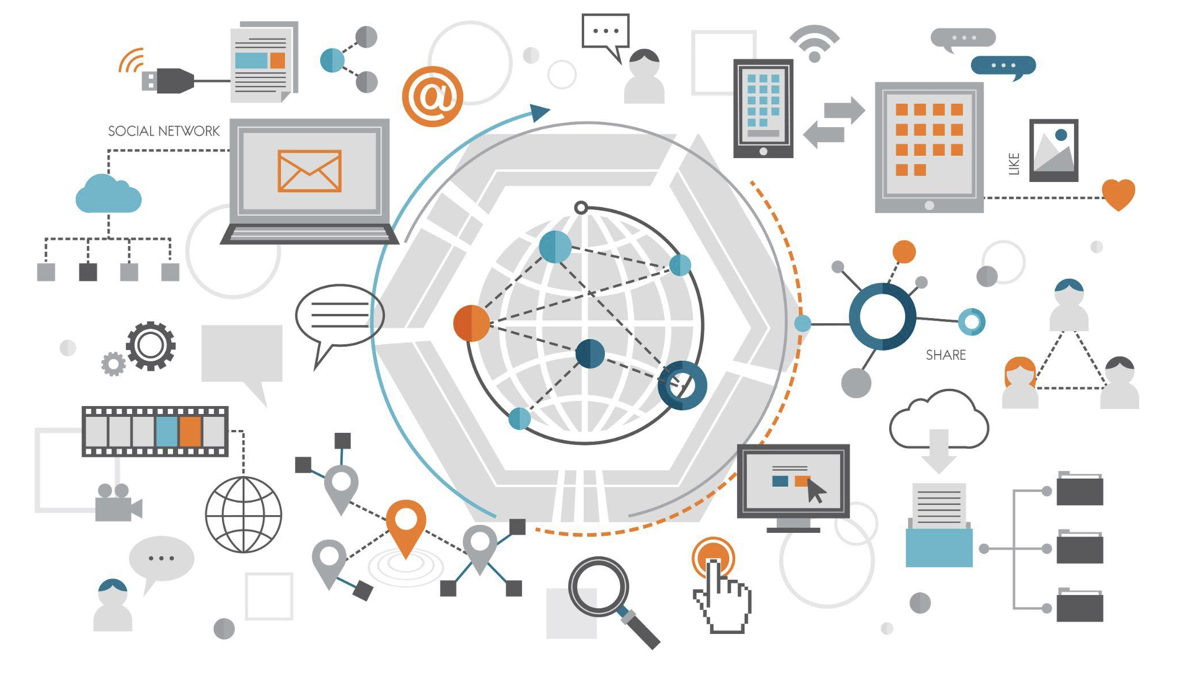What Is a Network Map?
Network maps, also known as network diagrams or network topologies, are visual representations of the relationships and connections between various devices, components, and nodes within a computer network. These maps are essential tools for network administrators, engineers, and IT professionals to understand, manage and troubleshoot complex networks.
Given the increasingly distributed nature of networks, network mapping has become even more crucial in today’s interconnected world. The rapid growth of remote working, cloud computing, and the Internet of Things (IoT) has led to networks becoming more decentralized and geographically dispersed, making them more challenging to manage and secure. Network maps allow for a comprehensive understanding of these intricate systems, enabling better decision-making and efficient resource allocation, and also supporting application mapping.
By illustrating the layout and connections within a network, network maps provide invaluable insights into the overall structure, performance and potential vulnerabilities. They allow for proactive identification of issues, such as bottlenecks, congestion points and single points of failure, leading to more effective network optimization and increased network resilience.
How Does Network Mapping Work?
Network mapping is the process of discovering and visualizing the components, connections, and structure of a computer network. It involves several steps, including data collection, analysis, and visualization, to create a comprehensive map of the network. Here’s an overview of how network mapping works:
1. Data collection: The first step in network mapping is gathering information about the devices, components, and connections within the network. This can be achieved using various methods, such as:
- Network scanning: Network scanners, like Nmap or Zenmap, can actively probe devices on the network to identify their IP addresses, open ports, and running services.
- SNMP: Simple Network Management Protocol (SNMP) is a widely-used protocol that allows network devices to share information about their status, configuration, and performance with network management systems.
- Network monitoring tools: Tools like SolarWinds Network Performance Monitor, PRTG, or Zabbix can passively collect data about the devices and connections in the network by monitoring traffic, analyzing logs, or querying device configuration databases
2. Data analysis: Once the data is collected, it needs to be analyzed to identify the devices, their roles, and the relationships between them. This step may involve:
- Device identification: Determining the type of each device (e.g., router, switch, server, workstation) and its function within the network.
- Connection mapping: Establishing the connections between devices, including their physical links (e.g., Ethernet, fiber, Wi-Fi) and logical relationships (e.g., subnets, routing paths, VLANs).
- Network metrics: Calculating network performance metrics, such as latency, throughput, and packet loss, which help to identify potential bottlenecks or issues in the network.
3. Visualization: The final step in network mapping is creating a visual representation of the network’s structure, connections, and components. Visualization tools, such as Microsoft Visio, Lucidchart or specialized network mapping software like SolarWinds Network Topology Mapper, can be used to generate network maps in various formats, including:
- Physical topology: This type of map displays the physical layout of network devices and the connections between them, providing insights into the network’s infrastructure and potential physical limitations.
- Logical topology: This map focuses on the logical relationships between devices, such as IP addressing schemes, routing paths, and VLANs, revealing the flow of data within the network.
Network Mapping Use Cases
Network mapping is the process of visually representing the components and connections within a network. It plays a crucial role in network management, security and optimization. Here are some common use cases for network mapping:
- Network inventory and documentation: Network mapping helps organizations create and maintain an up-to-date inventory of network devices, connections, and configurations. This documentation is essential for troubleshooting, planning, and maintaining an organized and efficient network.
- Network monitoring and troubleshooting: A visual representation of the network topology enables network administrators to monitor the performance and health of network devices and connections. In the event of an issue, network mapping simplifies the process of identifying the root cause and resolving problems quickly.
- Hybrid cloud architecture visualization: Network mapping provides a visual representation of your hybrid cloud environment, displaying the connections and dependencies between on-premises resources, private clouds, and public clouds. This enables IT teams to understand the overall architecture and efficiently manage resources across the hybrid environment.
- Security and risk assessment: Network mapping provides a clear picture of the network landscape, making it easier to identify potential vulnerabilities and risks. By understanding the network topology, administrators can implement appropriate security measures, such as firewalls, intrusion detection systems, and access controls, to protect the network from threats.
- Incident response and forensics: In the event of a security breach or incident, network mapping can aid in the investigation and response process by providing a visual representation of affected devices and connections. This helps incident response teams quickly identify the scope and impact of an attack, contain it, and begin the remediation process.
Network Mapping in OpenStack
OpenStack, a popular open-source cloud computing platform, offers robust capabilities for managing and orchestrating a wide range of IT resources, including compute, storage and networking services. Network mapping in OpenStack is a critical function that allows IT administrators to visualize and manage complex network structures within their cloud environments.
Neutron: OpenStack’s Networking Service
The key component responsible for network mapping in OpenStack is Neutron, the platform’s Networking-as-a-Service offering. Neutron provides a scalable, API-driven service for managing networks and IP addresses within the OpenStack cloud. It supports a wide range of networking models, including flat networks, VLANs, VXLANs, and GREs, and can be extended with additional services such as Load Balancing as a Service (LBaaS), Firewall as a Service (FWaaS), and VPN as a Service (VPNaaS).
Neutron uses a logical abstraction model to represent the network topology in an OpenStack cloud. At a high level, the model includes three main elements:
- Networks: A network represents an isolated Layer-2 broadcast domain, which can be either physical (e.g., a VLAN) or virtual (e.g., an overlay network).
- Subnets: A subnet represents a range of IP addresses that can be allocated to devices within a network.
- Ports: A port represents a connection point for devices to attach to a network. Each port is associated with an IP address from a subnet on the network.
Creating a Network in OpenStack
To create a network in OpenStack, you can use the Neutron API or the Horizon dashboard, OpenStack’s web-based user interface. Here are the general steps:
- Create a network: This is the first step in setting up your network topology. You can create one or more networks as needed, specifying the type of network (flat, VLAN, VXLAN, GRE) and any other relevant parameters.
- Create a subnet: For each network, you create a subnet by specifying the IP address range, gateway IP, and other relevant details.
- Create ports: Finally, you create ports on the network for devices to connect to. Each port gets an IP address from the subnet and can be associated with a specific device, such as a virtual machine or a router.
Visualizing the Network Map
OpenStack’s Horizon dashboard provides a network topology view, which is a visual representation of the network structure within the cloud. It shows the networks, subnets, ports, and associated devices, allowing you to see at a glance how everything is connected. This view can be incredibly useful for understanding the network architecture, troubleshooting network issues, and planning network changes.
In conclusion, network mapping in OpenStack, primarily managed through Neutron, provides a clear, visual representation of the various network elements within your cloud environment. By understanding these components and how they interact, you can effectively manage and optimize your OpenStack network, ensuring the smooth operation of your cloud services.
Network Mapping Best Practices
Here are some best practices to ensure an effective networking mapping process.
Determine the Scope of Network Map
Determining which components to include in the network map is crucial for creating an accurate and meaningful representation of the network. By selecting the most relevant components, IT professionals can focus on key devices and connections that significantly impact the network’s performance, security, and overall functionality. Some essential components to include are IP addresses, filters and firewalls, and the infrastructural layout.
Conversely, including too many insignificant elements can make the map overly complex, making it difficult to analyze and manage. Therefore, selecting the right components ensures that network maps remain practical, insightful, and valuable tools for network management.
Establish a Mapping Policy
Creating a network mapping policy is important to ensure consistency, accuracy, and regular updates of network maps. A well-defined policy establishes guidelines for collecting data, determining which components to include, and how often to update the maps. By including performance indicators and baselines, the policy enables the identification of deviations from expected performance levels and helps track changes over time.
Choose the Map Generation Approach
Choosing an approach to generating the network map depends on factors such as network size, complexity, and available resources:
- Auto-discovery tools offer automated, real-time network mapping, ideal for large, dynamic networks.
- Data file imports leverage existing network data from monitoring systems, suitable for networks with well-documented configurations.
- Manual entries provide full control over the mapping process, fitting smaller networks or specific use cases.
Choose a Dynamic Network Mapping Tool
Dynamic network mapping solutions with capabilities such as auto-discovery, traffic flow visualization, and physical connection mapping provide several advantages. These solutions offer real-time, up-to-date network maps that adapt to network changes, reducing manual maintenance efforts. Multiple views of the network enhance understanding of various aspects, like logical and physical relationships, traffic patterns, and performance metrics. This comprehensive visualization leads to better decision-making, quicker troubleshooting, and more efficient resource allocation.
Conclusion
In conclusion, network mapping is a fundamental aspect of effective network management, providing invaluable insights into computer networks’ structure, connections, and performance. As the complexity and distribution of networks continue to grow, network mapping becomes even more essential for ensuring network resilience and security.
This beginner’s guide has highlighted the importance of selecting components, choosing an appropriate mapping approach, and considering dynamic network mapping solutions. By understanding the basics of network mapping and implementing a well-defined network mapping policy, IT professionals can effectively manage, troubleshoot, and optimize their networks, contributing to a more reliable, secure and efficient digital infrastructure.
- Kubernetes Troubleshooting: A Practical Guide - May 21, 2024
- Overview of the OpenStack Documentation - March 18, 2024
- Refactoring Your Application for OpenStack: Step-by-Step - December 27, 2023

)










